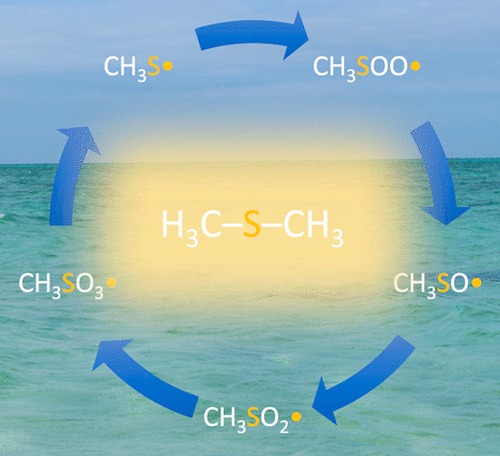当前位置:
X-MOL 学术
›
Acc. Chem. Res.
›
论文详情
Our official English website, www.x-mol.net, welcomes your feedback! (Note: you will need to create a separate account there.)
Atmospherically Relevant Radicals Derived from the Oxidation of Dimethyl Sulfide
Accounts of Chemical Research ( IF 18.3 ) Pub Date : 2018-02-02 00:00:00 , DOI: 10.1021/acs.accounts.7b00536 Artur Mardyukov 1 , Peter R. Schreiner 1
Accounts of Chemical Research ( IF 18.3 ) Pub Date : 2018-02-02 00:00:00 , DOI: 10.1021/acs.accounts.7b00536 Artur Mardyukov 1 , Peter R. Schreiner 1
Affiliation

|
The large number and amounts of volatile organosulfur compounds emitted to the atmosphere and the enormous variety of their reactions in various oxidation states make experimental measurements of even a small fraction of them a daunting task. Dimethyl sulfide (DMS) is a product of biological processes involving marine phytoplankton, and it is estimated to account for approximately 60% of the total natural sulfur gases released to the atmosphere. Ocean-emitted DMS has been suggested to play a role in atmospheric aerosol formation and thereby cloud formation. The reaction of ·OH with DMS is known to proceed by two independent channels: abstraction and addition. The oxidation of DMS is believed to be initiated by the reaction with ·OH and NO3· radicals, which eventually leads to the formation of sulfuric acid (H2SO4) and methanesulfonic acid (CH3SO3H). The reaction of DMS with NO3· appears to proceed exclusively by hydrogen abstraction. The oxidation of DMS consists of a complex sequence of reactions. Depending on the time of the day or altitude, it may take a variety of pathways. In general, however, the oxidation proceeds via chains of radical reactions. Dimethyl sulfoxide (DMSO) has been reported to be a major product of the addition channel. Dimethyl sulfone (DMSO2), SO2, CH3SO3H, and methanesulfinic acid (CH3S(O)OH) have been observed as products of further oxidation of DMSO. Understanding the details of DMS oxidation requires in-depth knowledge of the elementary steps of this seemingly simple transformation, which in turn requires a combination of experimental and theoretical methods. The methylthiyl (CH3S·), methylsulfinyl (CH3SO·), methylsulfonyl (CH3SO2·), and methylsulfonyloxyl (CH3SO3·) radicals have been postulated as intermediates in the oxidation of DMS. Therefore, studying the chemistry of sulfur-containing free radicals in the laboratory also is the basis for understanding the mechanism of DMS oxidation in the atmosphere. The application of matrix-isolation techniques in combination with quantum-mechanical calculations on the generation and structural elucidation of CH3SOx (x = 0–3) radicals is reviewed in the present Account. Experimental matrix IR and UV/vis data for all known species of this substance class are summarized together with data obtained using other spectroscopic techniques, including time-resolved spectroscopy, electron paramagnetic resonance spectroscopy, and others. We also discuss the reactivity and experimental characterization of these species to illustrate their practical relevance and highlight spectroscopic techniques available for the elucidation of their geometric and electronic structures. The present Account summarizes recent results regarding the preparation, characterization, and reactivity of various radical species with the formula CH3SOx (x = 0–3).
中文翻译:

源自二甲基硫醚氧化的大气相关自由基
大量和大量的挥发性有机硫化合物散发到大气中,以及它们在各种氧化态下的反应种类繁多,因此即使对其中的一小部分进行实验测量也是一项艰巨的任务。二甲基硫醚(DMS)是涉及海洋浮游植物的生物过程的产物,据估计约占释放到大气中的自然硫气体总量的60%。有人提出,海洋排放的DMS在大气气溶胶的形成以及由此而形成的云中起着作用。已知·OH与DMS的反应通过两个独立的途径进行:抽象和加成。据信DMS的氧化是由与·OH和NO 3 ·自由基的反应引发的,最终导致形成硫酸(H2 SO 4)和甲磺酸(CH 3 SO 3 H)。DMS与NO 3 ·的反应似乎仅通过夺氢进行。DMS的氧化由一系列复杂的反应组成。根据一天中的时间或海拔高度,可能会采取多种途径。但是,一般而言,氧化是通过自由基反应的链进行的。据报道,二甲基亚砜(DMSO)是加成通道的主要产物。二甲基砜(DMSO 2),SO 2,CH 3 SO 3 H和甲烷磺酸(CH 3已观察到S(O)OH)是DMSO进一步氧化的产物。了解DMS氧化的细节需要深入了解这种看似简单的转化的基本步骤,而这反过来需要将实验方法和理论方法结合起来。甲基噻吩基(CH 3 S·),甲基亚磺酰基(CH 3 SO·),甲基磺酰基(CH 3 SO 2 ·)和甲基磺酰氧基(CH 3 SO 3)·)自由基被假定为DMS氧化的中间体。因此,在实验室中研究含硫自由基的化学性质也是理解大气中DMS氧化机理的基础。矩阵隔离技术结合量子力学计算在CH 3 SO x(x= 0–3)在当前帐户中审核了部首。汇总了该物质类别所有已知物质的实验矩阵IR和UV / vis数据,以及使用其他光谱技术(包括时间分辨光谱,电子顺磁共振光谱等)获得的数据。我们还将讨论这些物种的反应性和实验特性,以说明它们的实际相关性,并着重介绍可用于阐明其几何结构和电子结构的光谱技术。本帐户总结了有关各种自由基物质的制备,表征和反应性的最新结果,分子式为CH 3 SO x(x = 0-3)。
更新日期:2018-02-02
中文翻译:

源自二甲基硫醚氧化的大气相关自由基
大量和大量的挥发性有机硫化合物散发到大气中,以及它们在各种氧化态下的反应种类繁多,因此即使对其中的一小部分进行实验测量也是一项艰巨的任务。二甲基硫醚(DMS)是涉及海洋浮游植物的生物过程的产物,据估计约占释放到大气中的自然硫气体总量的60%。有人提出,海洋排放的DMS在大气气溶胶的形成以及由此而形成的云中起着作用。已知·OH与DMS的反应通过两个独立的途径进行:抽象和加成。据信DMS的氧化是由与·OH和NO 3 ·自由基的反应引发的,最终导致形成硫酸(H2 SO 4)和甲磺酸(CH 3 SO 3 H)。DMS与NO 3 ·的反应似乎仅通过夺氢进行。DMS的氧化由一系列复杂的反应组成。根据一天中的时间或海拔高度,可能会采取多种途径。但是,一般而言,氧化是通过自由基反应的链进行的。据报道,二甲基亚砜(DMSO)是加成通道的主要产物。二甲基砜(DMSO 2),SO 2,CH 3 SO 3 H和甲烷磺酸(CH 3已观察到S(O)OH)是DMSO进一步氧化的产物。了解DMS氧化的细节需要深入了解这种看似简单的转化的基本步骤,而这反过来需要将实验方法和理论方法结合起来。甲基噻吩基(CH 3 S·),甲基亚磺酰基(CH 3 SO·),甲基磺酰基(CH 3 SO 2 ·)和甲基磺酰氧基(CH 3 SO 3)·)自由基被假定为DMS氧化的中间体。因此,在实验室中研究含硫自由基的化学性质也是理解大气中DMS氧化机理的基础。矩阵隔离技术结合量子力学计算在CH 3 SO x(x= 0–3)在当前帐户中审核了部首。汇总了该物质类别所有已知物质的实验矩阵IR和UV / vis数据,以及使用其他光谱技术(包括时间分辨光谱,电子顺磁共振光谱等)获得的数据。我们还将讨论这些物种的反应性和实验特性,以说明它们的实际相关性,并着重介绍可用于阐明其几何结构和电子结构的光谱技术。本帐户总结了有关各种自由基物质的制备,表征和反应性的最新结果,分子式为CH 3 SO x(x = 0-3)。



























 京公网安备 11010802027423号
京公网安备 11010802027423号